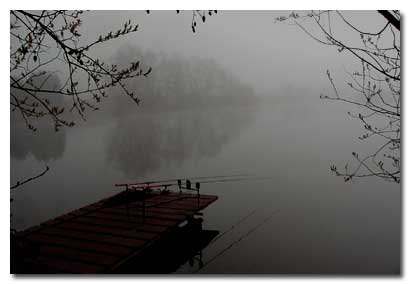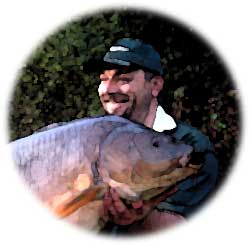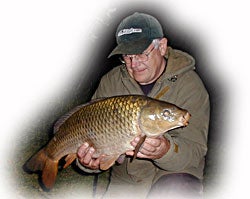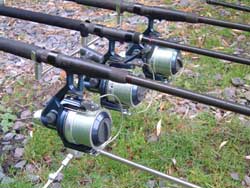| BIG RIK (CARP ANGLER) | |
Rik started fishing at the age of four on his local tiny tidal river, catching eels and small wild trout on worm. Not having had any angling family members, all his early fishing was solitary and this seems to have carried through to the present. Like most anglers nowadays, he has a full time job and a family, so his fishing time is limited, although he does, he tells us, have a very understanding wife.He currently lives in the depths of Hampshire, and so is within easy reach of some excellent venues. He has in the past, and still does, fish for most species, although his greatest love is for carp fishing, which is how the majority of his time is spent. He now finds himself more thrilled with overcoming the intricacies and problems associated with catching carp, rather than the actual weight of the fish he catches and the so-called glory that goes with it. |
THE FINER POINTS OF WINTER FISHING With winter almost upon us and having received some e-mails and forum postings asking advice on winter tactics, I thought I’d put finger to keyboard and pass on some of my thoughts on the subject. So, as the title suggests, I’m going to concentrate on fining everything down. This can only really be achieved if your venue is appropriate for it. During the summer the weed and lilies, etc, mean that you need to fish with a certain strength of gear to allow you to land your quarry. The line strength and rod will be determined by the size of fish expected and the venue’s snags. During the winter, most of the weed and lilies will die off and this gives us the opportunity to fish lighter and finer. If your lake contains snag trees, bushes, sharp bars or other non-seasonal snags, then you shouldn’t fine down, for remember, it’s only if your venue is appropriate for it. The carp’s welfare always comes first.
Mainline strength Although not a major advantage in its own right, apart from allowing you to cast further, balancing the line strength with the hooklink strength is most advisable. Some feel that a finer mainline will be less detectable, but having your mainline disguised is a good all year round tactic. I normally fine down to a mainline of 12lb, feeling this is adequate enough and don’t feel that I need to go any lighter. When I say 12lb, I mean it, not lines sold as 12lb. I’ve previously used Shimano Technium, but this year I’m using Maver’s excellent Jurassic Twin Core. This, like the Technium, is a mono/braid hybrid, with a silky exterior, giving good casting properties. It’s a naturally sinking line with an honest diameter. The 12lb has a diameter of 0.27mm. Compare this to nearly all the 10lb ‘carp’ mono’s on the market, which have a diameter of 0.30mm Hooklink strength Hooklink strength or diameter is a major advantage during the winter. A finer hooklink is less detectable, allowing the bait to act more naturally and allowing a certain finesse to be employed. This should be balanced with hook and bait size, which I’ll cover later.
Bait size and type With a lot of the other resident species being less active in the winter we can use baits other than large boilies without fear of constantly winding in fish which aren’t our specified target. (I said all that without once using the term ‘nuisance’). Smaller boilies of 10mm, sweetcorn, maize, maggots and casters are superb winter baits. Carp will feed less, so a smaller, more particle type approach will mean the fish will have more chance of making a mistake when they’re in a pre-occupied feeding state. Mixing these baits with hemp, which is a superb feed at any time of the year, will enable you to create this more active feeding state. Hook size Hook sizes should be gauged to the bait size and the mainline strength. Try to marry these things but lean towards the finer end, always keeping in mind the ability to land the fish. It’s no good getting take after take on single corn to a lightweight size 10 hook if every fish straightens the hook as you try to keep its head away from those marginal reeds. Look around and assess your swim and how you’re going to play the fish. If you’ve open water and no snags, then lighter and finer will get you more bites, but not at the expense of the fish. Boilies of 10mm and single or double corn are more suited to a size 8 or 10 hook, allowing a better presentation with a greater chance of a take. If you feel that you need to step up the hook size and strength to be able to land the fish, then make sure you step up your line strength as well. You’ll not get much penetration on a heavy gauge size 4 hook and 10lb hooklink. Keep everything balanced and you’ll be able to land them. Lead size People tend to bring their lead size down as well as everything else, as I will if the situation demands it. But for me, the lead size is determined by the distance I need to cast as well as other contributing factors. These factors are the same summer or winter If you’re fishing a running lead and medium weight indicator (to negate undertow) and you’ve found that a 3oz lead gives the optimum bite indication, given the conditions, then trimming down to a 11/2 oz lead will not gain you any advantage.
Bite Indication See above – remember to balance your indicators against your lead size. General Tactics Overview
Those are some of the tactics I use during the winter, but should not to be read as the definitive article. Use what I’ve written to question what and why you are doing certain things in your quest for carp this winter. Don’t change your gear or tactics unless you know why you are doing it. It’s wise to have a reason why and to make sure it’s the right reason. |















